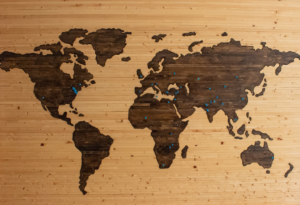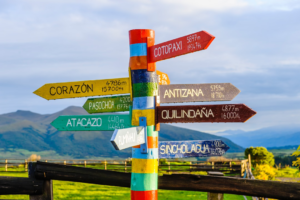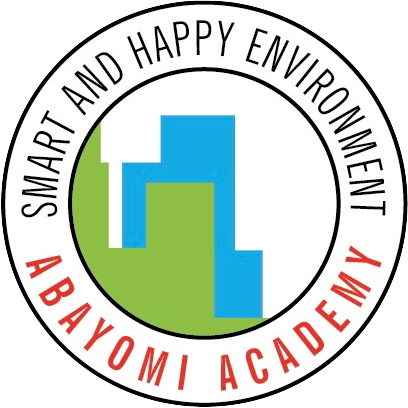The covid-19 and the disruptive challenge of “In-Migrate”
By Selma Mosquera
Yesterday a phrase popped into my mind and kept coming back to me. No matter how much I focused on other things, again and again the subject reappeared in my mind. Today I woke up with it still surrounding me before I even got out of bed. So, I decided to give it a little more attention. I stopped to ponder why the Universe was constantly blowing this topic into my ears. What should I learn from it?
By now, your curiosity on the other side must be overflowing, right? But what is she talking about? What could be troubling so much as to make her jump out of bed straight to the computer so that her don’t have a chance for such an idea to fall into oblivion?
Dear reader, I am referring to “Covid-19 and the Challenge to “In-Migrate”.
And that is what we will be dialoguing about in the following paragraphs.

For those who don’t know me, I am Selma Mosquera and besides being in love with the Human Being, Migration is currently part of my theoretical and practical studies (and learning). Not only because of the doctoral thesis I am working on at the Instituto Superior de Ciências Sociais e Políticas (ISCSP) of the University of Lisbon; nor because I manage the Associação de Migrantes de Torres Vedras – AMTV, where I am president of the Board, but, above all, because I decided, along with my husband and children, to leave Brazil – the country where I was born and lived for many years – to live in Portugal in order to fulfill a childhood dream (to become a scientist), which officially makes me a Migrant HUMAN BEING.
If we stop to think about the migration issue in a little bit more depth, we will realize that, in fact, the migration issue is nothing new. The act of migrating has accompanied humanity since the beginning of time. It was the sedentary lifestyle at that time that emerged as a novelty. Gradually, as they settled in certain regions of our planet, mankind had the opportunity not only to interact intensely with the place where they were, but also to live with the ecosystem around them and learn a lot about it.
People thus began to mark territory, to build their own culture for their community. Influenced by the geography and climate of the place, they created habits, customs, art, architecture, science… All this fruit of observation and interaction with the environment around them. Thus, the world became known. And the more they got to know it, the more they transformed it.
However, pressured by wars between peoples, lack of food, ecological disasters, and even political-economic issues, many of these people found themselves – and still find themselves – forced to migrate elsewhere in search of a better life. Over time the migratory flow has intensified to such an extent that governments have been forced to implement their own migration policies in order to preserve their territories.
This is how countries were pressured to create their own laws to define who could enter their borders with a status that goes beyond that of a tourist. They created criteria for those who will (with)live in their territory, who will constantly interact with the natives of the region, thus being able to influence the transformation of their “space”.

Milton Santos tells us that the interaction with new spaces allows us to build new geographies. This, in turn, enables us to learn new ways of looking at things that allow us to reorganize resources to meet existing needs, create new needs, and innovate by creating other resources to meet previously unknown needs. It makes us think about how disruptive and entrepreneurial the act of migrating is. How much this decision makes us grow!
Until then, humanity had been used to explore the outside world, to get out of “Plato’s cave” to know what was unknown outside. Suddenly, on this path, humanity comes across a small virus, the SARS COV-2, which presents it with a pandemic world capable of inverting the logic of the social-spatial interaction model already known to it.
In an interval of a little more than a year we were forced, as a matter of survival of our species, to return to the cave, which as a rule had been transformed into an overnight space, to live and socialize mediated by information and communication technologies – ICTs.
This new reality made us realize that we were unaware of something we thought we were very well aware of our own home. Once again, sedentarism comes back into fashion, bringing with it consequences for physical and mental health. But it also gives us more time to interact with this so-called “already known” space. We returned home, forcefully, with a more attentive look. This new look allowed us to see and feel the need to build a new internal geography, in the Miltonian style.
Regardless of whether we lived alone or cohabited with other people, we began to experience a strangeness of what we knew as our inner space. From this old-new place, we were forced to adapt in order to move on. Work invaded our home, school invaded our home, the nuclear family invaded our home, and our individuality also invaded our home. All at the same time now. All to stay.
It was then that we realized that there were many things inside our house that we didn’t like; others that we didn’t need; others that were needed but didn’t have; others that we just wanted. And the need for reorganization became present.
In the same way, we realized that we had strange habits, that we didn’t know the people we lived with, and that we didn’t know ourselves. We realized how gregarious we are and how much we build ourselves through interaction with others. How much we miss the other! Once again, the need for reorganization was present.
In the blink of an eye the challenge of “In-Migrate” was imposed on us. We had to live with the person who was closest to us: ourselves. In this process our shadows, our fears, our points to be improved came to the surface. But also emerged our capacity for resilience, for positive adaptation, to accomplish more with less, to learn from our mistakes and successes, to forgive ourselves and others, to identify what really matters, etc.
Without a doubt, despite all the pain caused by this process of growth and learning, demarcated by the states of unbalance and rebalance that the Piagetian viewpoint teaches us, “In-Migrate” brought us a quantum opportunity to look inside and discover a new geography that allowed us to build a new inner architecture (as an individual) for the home we inhabit, for our community, for our city, and perhaps for our planet.
Suddenly, as I finish this writing/reflection, I am overcome by such a state of gratitude that I can only affirm it:
Thank you, SARS COV-2, for the opportunity to “In-Migrate”.
Hopefully, we will be able to extract our best geography from ourselves.
Peace and good.




